Micron M500DC (480GB & 800GB) Review
by Kristian Vättö on April 22, 2014 2:35 PM ESTPerformance Consistency
Performance consistency tells us a lot about the architecture of these SSDs and how they handle internal defragmentation. The reason we don’t have consistent IO latency with SSDs is because inevitably all controllers have to do some amount of defragmentation or garbage collection in order to continue operating at high speeds. When and how an SSD decides to run its defrag or cleanup routines directly impacts the user experience as inconsistent performance results in application slowdowns.
To test IO consistency, we fill a secure erased SSD with sequential data to ensure that all user accessible LBAs have data associated with them. Next we kick off a 4KB random write workload across all LBAs at a queue depth of 32 using incompressible data. The test is run for just over half an hour and we record instantaneous IOPS every second.
We are also testing drives with added over-provisioning by limiting the LBA range. This gives us a look into the drive’s behavior with varying levels of empty space, which is frankly a more realistic approach for client workloads.
Each of the three graphs has its own purpose. The first one is of the whole duration of the test in log scale. The second and third one zoom into the beginning of steady-state operation (t=1400s) but on different scales: the second one uses log scale for easy comparison whereas the third one uses linear scale for better visualization of differences between drives. Click the buttons below each graph to switch the source data.
For more detailed description of the test and why performance consistency matters, read our original Intel SSD DC S3700 article.
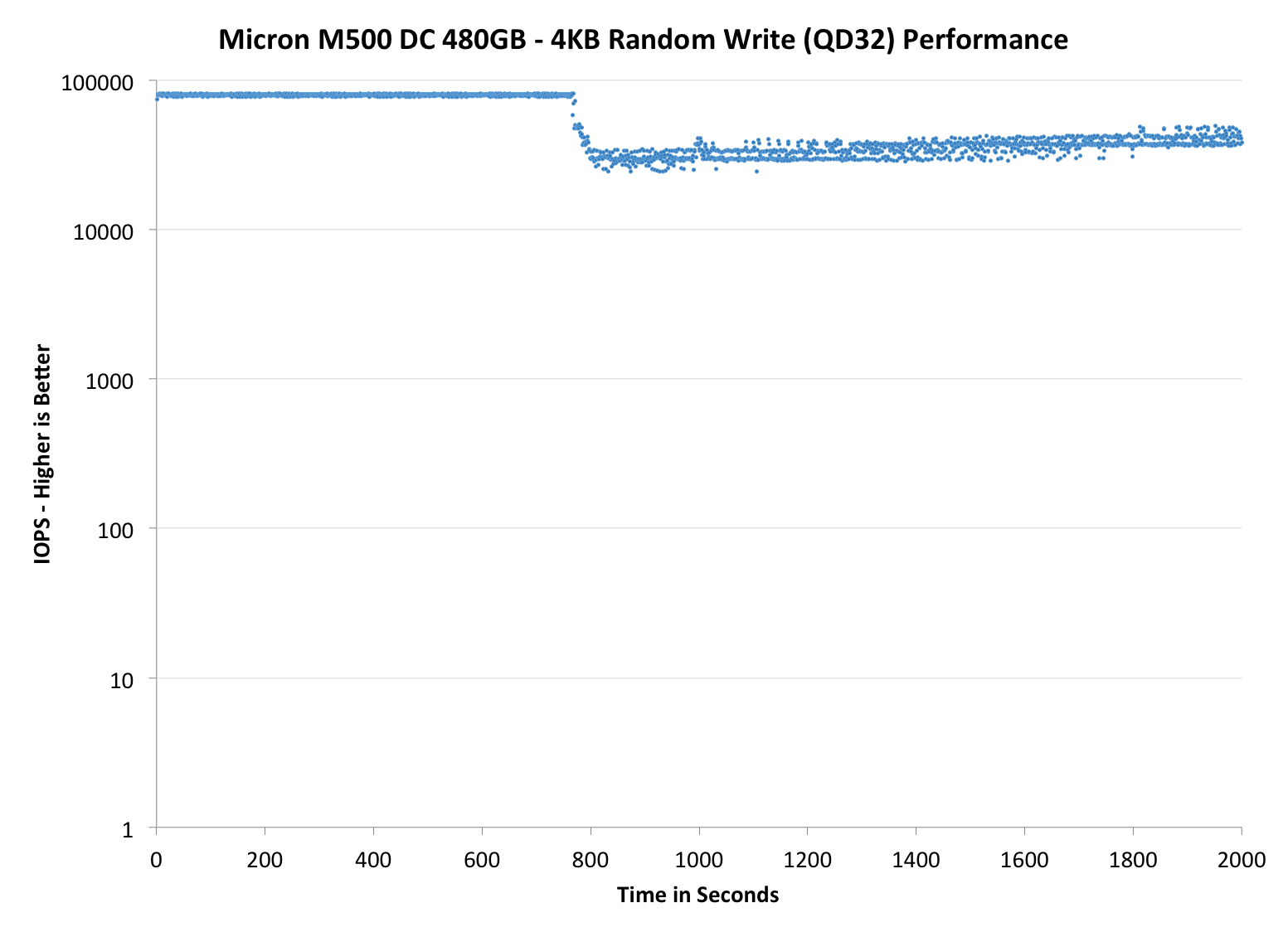 |
|||||||||
| Micron M500DC | Crucial M500 | Micron P400e | Micron P400m | Intel SSD DC S3500 | |||||
| Default |
|
||||||||
As you would expect with such hefty over-provisioning, the IO consistency is excellent. The 480GB model manages around 40K IOPS at steady-state, which is certainly one of the highest we have tested. (For the record, the Intel DC S3700 does about 33K but unfortunately there wasn't room in the table to include it.) The 800GB version doesn't do as well given its smaller over-provisioning percentage but it's relatively competitive with the 200GB P400m, which has 336GiB of NAND onboard (that's 44.6% total over-provisioning versus 27.2% in the 800GB M500DC). Compared with the P400m, the M500DC is, after all, a nice upgrade because it's able to improve IO consistency without using more over-provisioning to do that.
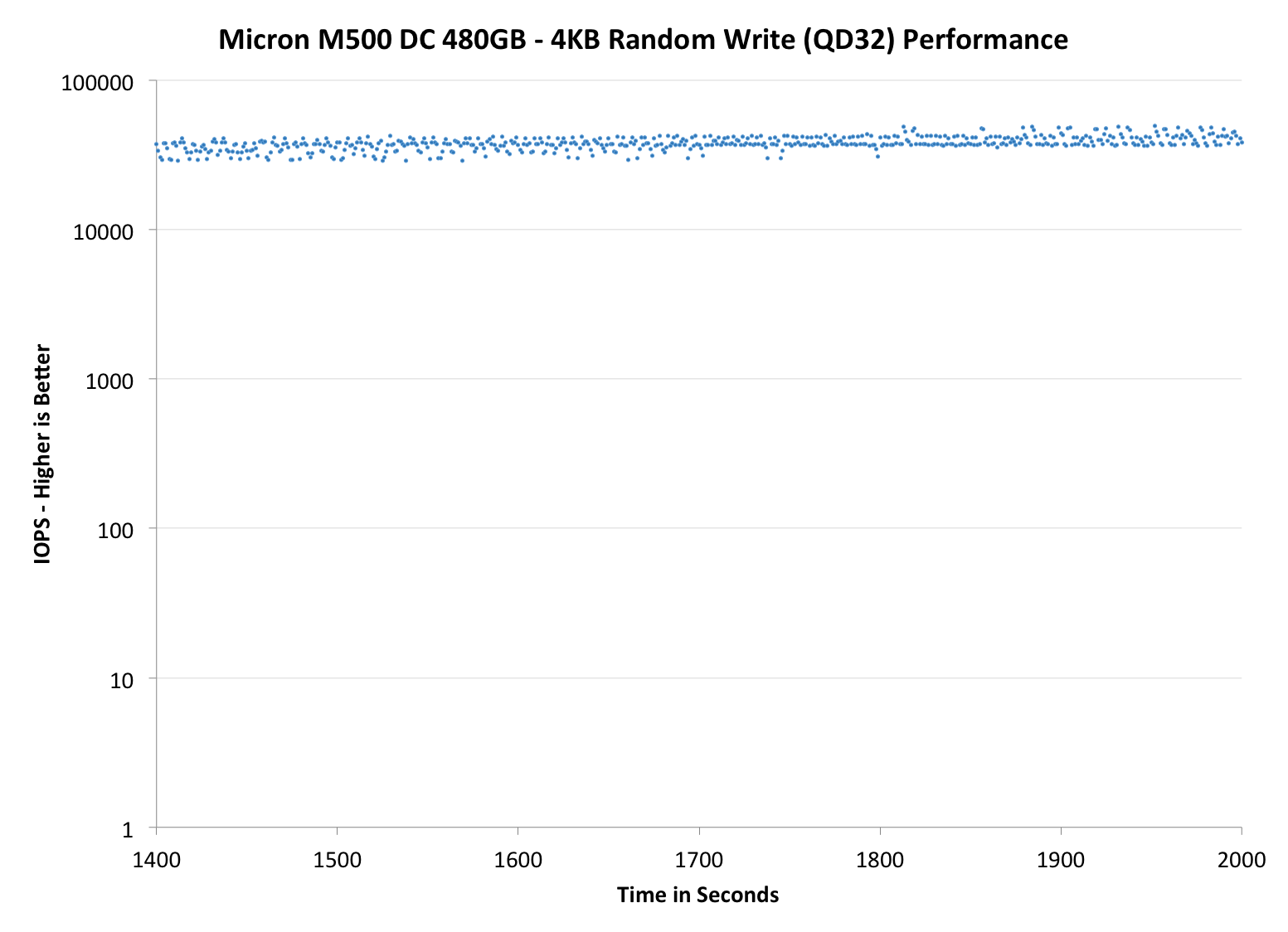 |
|||||||||
| Micron M500DC | Crucial M500 | Micron P400e | Micron P400m | Intel SSD DC S3500 | |||||
| Default |
|
||||||||
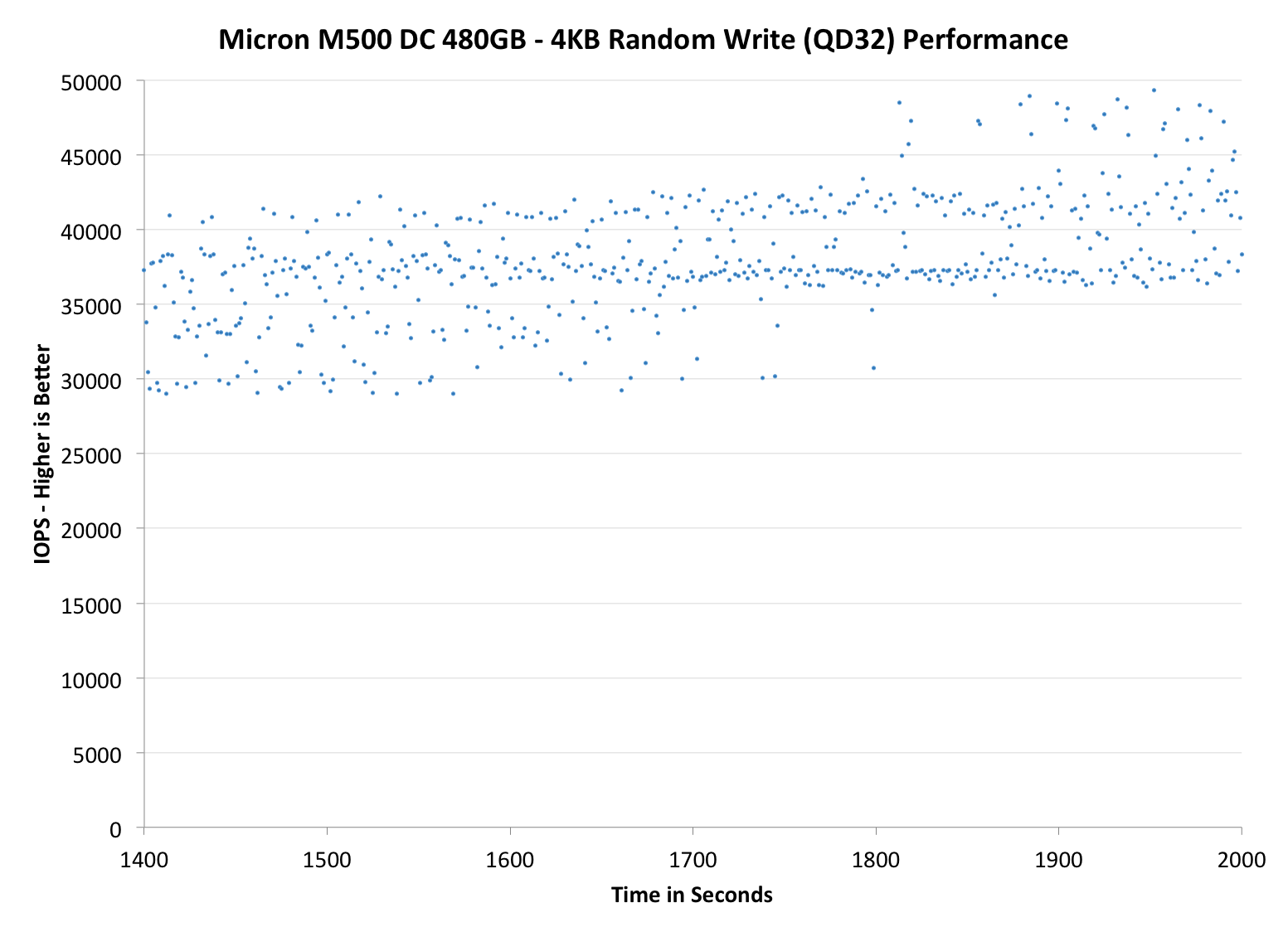 |
|||||||||
| Micron M500DC | Crucial M500 | Micron P400e | Micron P400m | Intel SSD DC S3500 | |||||
|
Default |
|
||||||||
In addition to our regular performance consistency graphs, I decided to include two additional graphs that test the IO consistency over a longer period of time. For client drives, 2000 seconds is generally enough to show steady-state behavior but enterprise SSDs tend to have more over-provisioning and hence require a longer time to reach steady-state. Instead of running the test for 2000 seconds, I extended the run to 7200 seconds (i.e. two hours) while keeping everything else the same. I only have results for the M500DC drives right now, but let's see if anything changes with a longer test cycle:
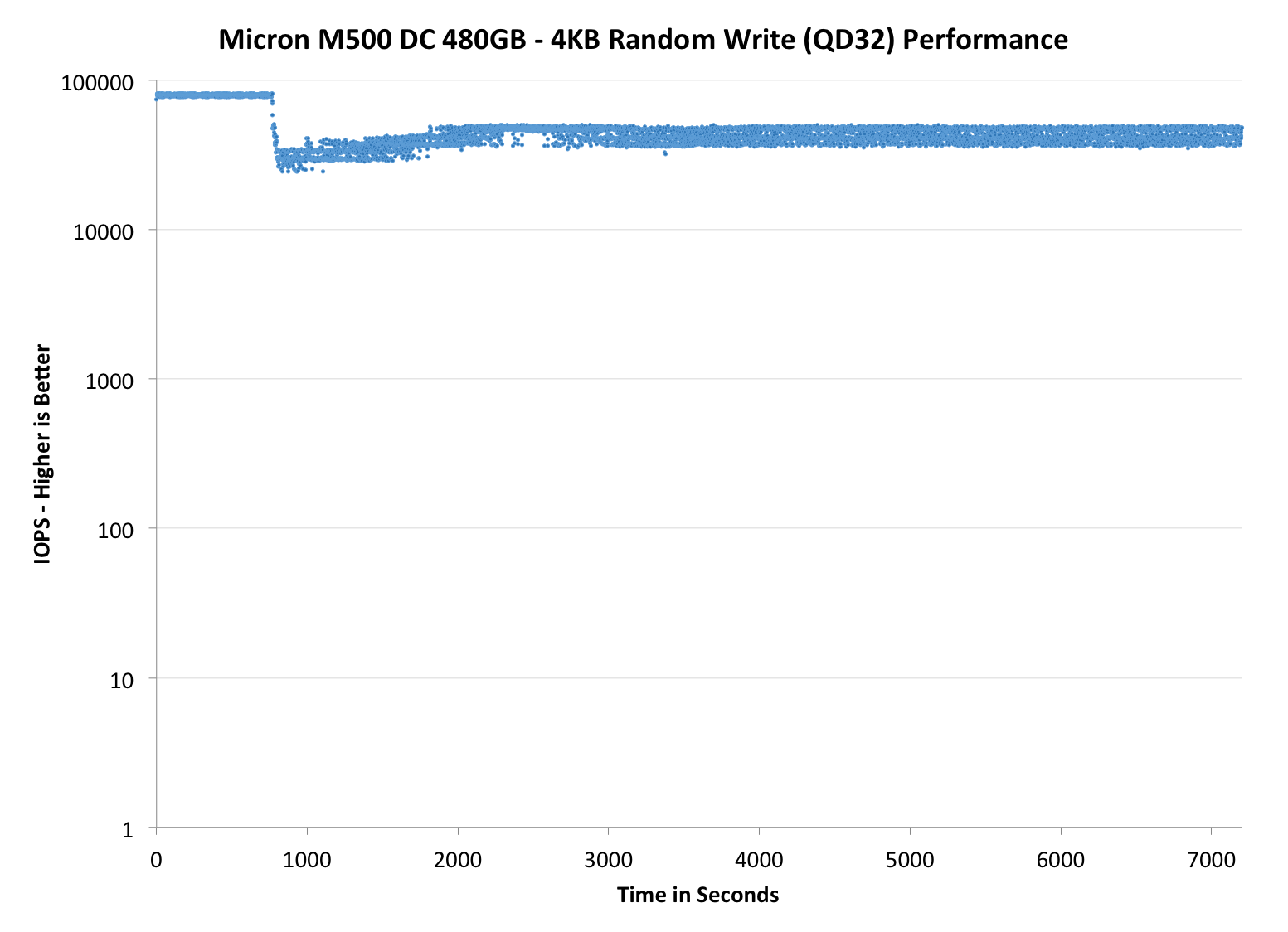
As you can see, neither of the drives show steady behavior right after 2000 seconds. In fact, it looks as though the initial trigger of data reordering drops performance and then the M500DC drives recover somewhat around the 3000 second mark, though the different amount of overprovisioning means they don't look all that similar. Unfortunately I don't have any results for other drives at this point but I'll be sure to test more drives before the next review to give you a better picture ot the M500DC's position in the market.
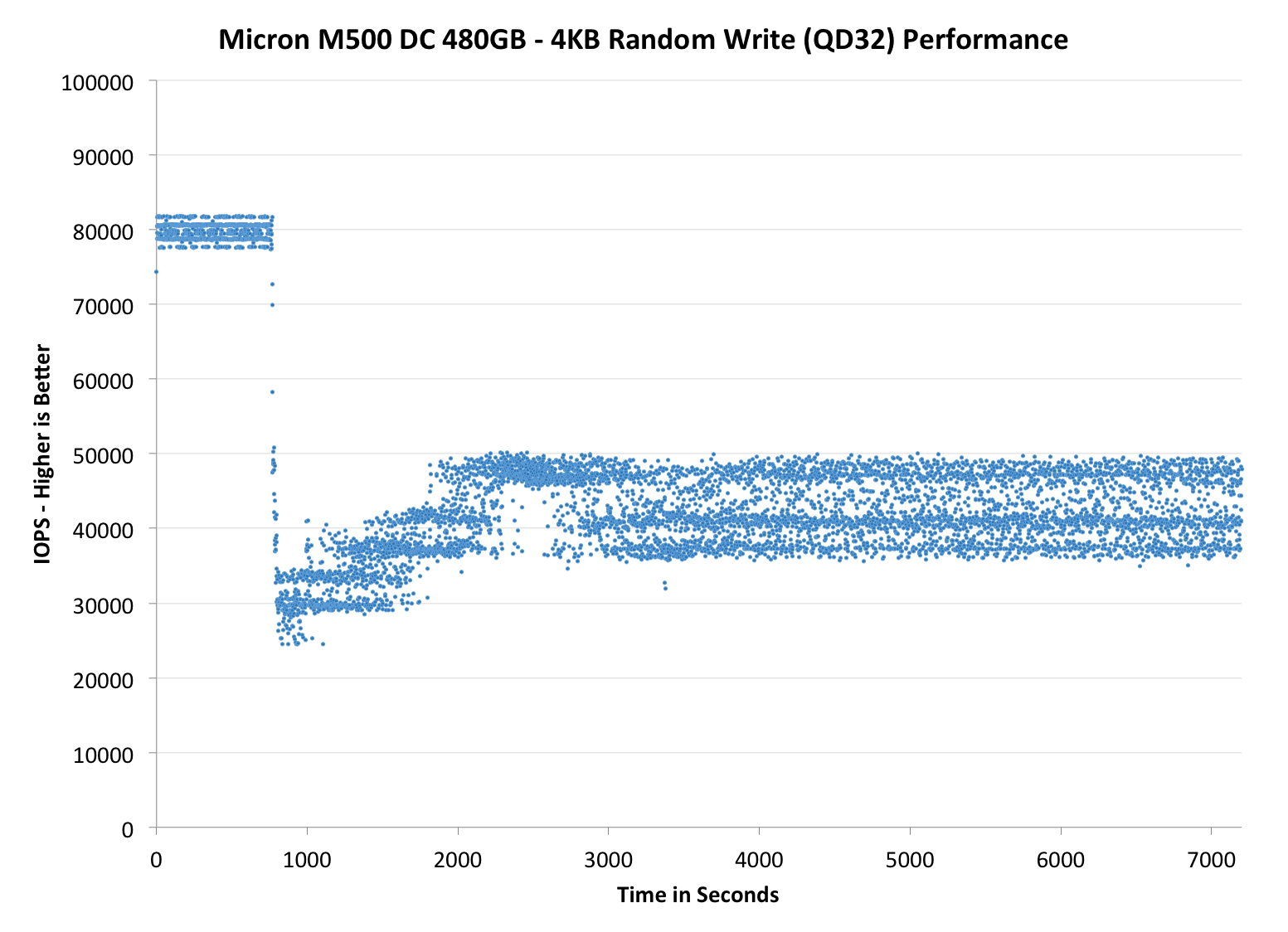










37 Comments
View All Comments
apudapus - Tuesday, April 22, 2014 - link
I don't quite understand your statement in the first part:data retention decreases with NAND wear -> consumer drives have higher endurance
Regarding the last sentence, SSD endurance is measured in number of writes like TBW. NAND endurance is measured in P/E cycles. The endurance of an SSD should not be measured in P/E cycles because erasing is handled internally to the SSD, there is no "erase" command to send to an SSD (trim does not directly yield an erase), write amplification (decreases endurance) and overprovisioning (increases endurance) must be taken into account and is not controlled by the user. Total writes is all that is needed when discussing SSD endurance. With that said, please explain your reasoning for the drive having a higher endurance than 3000 "P/E cycles".
Solid State Brain - Tuesday, April 22, 2014 - link
The more P/E cycles your NAND memory goes through, the shorter its data retention time gets.Therefore, the shorter the data retention requirement for the intended usage is, the more P/E cycles you can make your memory can go through (or in other words: the more data you can write). Actually it's a bit more complex than that (for example the uncorrectable bit error rate also goes up with wear), but that's pretty much it.
apudapus - Wednesday, April 23, 2014 - link
I see. So the assumption is that NAND with shorter data retention requires more refreshing (a.k.a. wasted programs). I believe this to be true for enterprise drives but I would be surprised to see this being done on consumer drives (maybe for TLC, though).valnar - Tuesday, April 22, 2014 - link
I wish they would find a way to lower the cost of SLC. Look at those endurance numbers.hojnikb - Tuesday, April 22, 2014 - link
Why would you want SLC anyway ?If you need endurance, HE-MLC is plety enough.
Unless you write like crazy; them probobly buying SLC shouldn't pose a problem :)
valnar - Tuesday, April 22, 2014 - link
Because 20nm TLC and crap like that barely holds a "charge", so to speak, when not powered up. That's just way too volatile for my liking. I'm not always running all my PC's every day.bji - Tuesday, April 22, 2014 - link
What difference does it make if the drive is powered up or not? These are static cells, they are not "refreshed" like DRAM. They are only refreshed when they are rewritten, and if your drive is not doing continuous writes, it's not guaranteed to rewrite any particular cell within any specific timeframe.apudapus - Tuesday, April 22, 2014 - link
NAND has limited data retention and should be refreshed like DRAM, albeit at a much larger timescale like 1 month (TLC) to a year (I believe 54nm SLC from years ago had this spec near the end of its life, ~100,000 P/E cycles). Good SSDs should be doing this.Kristian Vättö - Wednesday, April 23, 2014 - link
ALL consumer drives have a minimum data retention of one year, regardless of the type of NAND (SLC, MLC or TLC). This is a standard set by JEDEC. For enterprise drives it's three months.apudapus - Wednesday, April 23, 2014 - link
That may be the requirement for drives but not for NAND. Drives can do several things to increase data retention: refresh stale data after time, provide strong ECC, do voltage thresholding, etc. I think JEDEC specifies hundreds of hours for NAND retention.